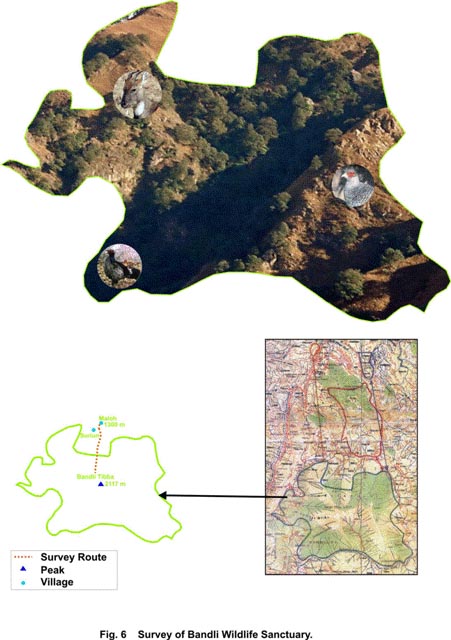Assessment of ecological profile of Bandli Wildlife Sanctuary and Tarambri Demarcated Protected Forest
|
Surveys of Bandli Wildlife Sanctuary and Tarambri Demarcated Protected Forest were carried out to assess the wildlife conservation values of these area and to evaluate the existing trends of pressures from the resource use by dependent communities. Tarambri DPF located in north of the limestone mine lease was surveyed to assess the ecological impacts of mining on the area that is almost contiguous to the proposed mining lease. The WII team surveyed Bandli Wildlife Sanctuary along a transect route of length about 6.5 km in a north to south direction beginning at the northern edge of the Sanctuary (Fig. 6). The survey route covered an altitudinal range between 1300 m at the start point to 2100 m at the end point near Bandli tibba, the highest peak in the Sanctuary. The observations made during the surveys aimed to generate the information on following aspects:
Vegetation characteristics: Major vegetation types were identified based on established classification system (Champion and Seth 1968). Dominant species of trees, shrubs and herbaceous vegetation along the survey route were determined and a broad assessment of the habitat quality in terms of food and cover value rendered by the vegetation characteristics of the study area was also made. Faunal characteristics: The occurrence of major faunal species of mammals was determined during the survey using direct and indirect evidences of species (Rodgers 1991, Sutherland 1996). Mammal species particularly carnivores may be elusive and direct sightings are not always possible. Therefore, the presence of animals in the area was established using indirect evidences such as pugmarks, scrapemarks and scats for carnivore species. For herbivores, faecal pellets of herbivore species were identified and recorded to determine occurrence of ungulates in the area. Opportunistic searches enabled recording the presence of other faunal groups including the avifauna and insect genera in the study area. Biotic pressures: To assess existing pressure on Bandli Wildlife Sanctuary from extraction of resources for fuelwood and fodder resources extraction, direct observations were made on number of headloads of fodder and fuel collected from the Sanctuary by human population of the surrounding villages. Grazing pressure on the Sanctuary due to additional factors such as the seasonal influx of migratory pastoralists with their livestock herds was also determined. |
Last Updated: October 5, 2015










